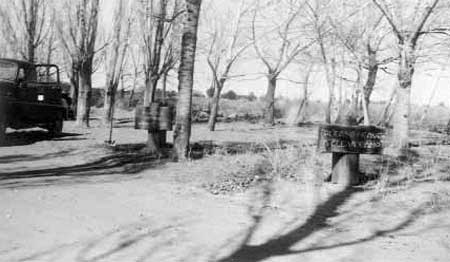|
PIPE SPRING
Cultures at a Crossroads: An Administrative History |

|
PART VII: THE CALM BEFORE THE COLD WAR (continued)
Floods
In spite of the improvement work of 1948, Pipe Spring National Monument had not seen the last of its floods. On August 11, 1950, Heaton described what was by now an all-too-familiar scene:
At 3:15 [p.m.] a heavy storm of hail and rain hit the monument. By 3:30 water was running everywhere, leaves and small twigs being knocked off the trees and plants. The ground was white with hail in 10 minutes. The heaviest hail was to the south of the monument about 2 miles. The ground stayed white till after dark. By 3:45 p.m. a flood came down the wash which was almost twice too large for the culvert and again as in 1942, the camp area, road, parking area and south was flooded, leaving piles of trash and sand over the area which will take several days to clean up. There was so much trash and hail in the flood that it built its own bank as it went along in places, 2 feet high. Very little washing was done because of the weeds and plants. The roads were blocked by washout and sand drifts across the road southwest and east and north. [1452]
Heaton described the event as "not quite as large a flood" as the one in 1942. Still, the flood deposited an estimated two to 18 inches of sand on the road from the parking area south of the fort to the east cattle guard and on the north side of the campground, and washed trash into monument trees and brush. [1453] Heaton hired Kelly Heaton to remove the sand from the monument road and campground area with a tractor and scraper later that month. Heaton then hauled in clay and several loads of gravel to build up the road where sections of it had washed out.

91. Monument campground and picnic area, June
1950
(Pipe Spring National Monument, neg. 8).
| <<< Previous | <<< Contents >>> | Next >>> |
pisp/adhi/adhi7i.htm
Last Updated: 28-Aug-2006